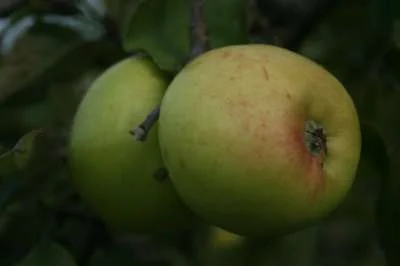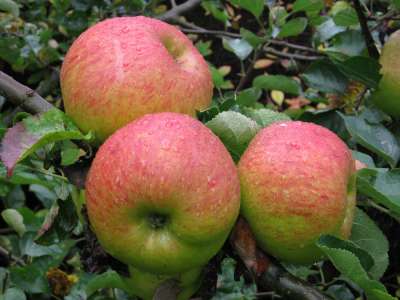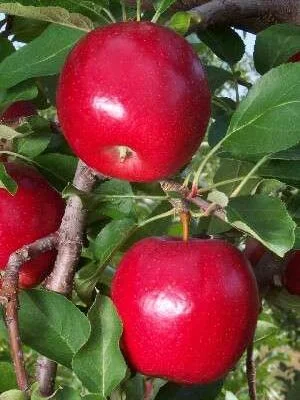Your basket is currently empty!
The Ultimate Guide to Cooking Apple Trees
Every fruit tree collection needs at least one cooking apple, they are of such value and adaptability, these kitchen classics are an indispensable source of fresh fruit for all your favourite cooking classics. Additionally cooking apples tend to be hardier than those that are purely for dessert eating, making them an ideal choice for less than ideal conditions and colder areas.
With careful selection you can have these flavoursome beauties in season from early August right through to May and with many varieties suited to home freezing, preserving and bottling you need never be without a supply on hand for your favourite apple pies, crumbles, tarts, puddings cakes, apple dumplings, or simply stewing with custard!
They can be grown in all the many ways that eating apples can and there are trees and rootstocks suited to container growing, lawn planting, larger specimens for traditional orchard, allotment and cordon and column trees. Most are also ideal for that awkward North or East facing wall where most other fruit trees will sulk – but they can also revel in the sun.
At the end of this article I will pick my top ten cooking apple varieties, carefully selected to cover the season too.
Rootstock selection
Here is a low-down of the various options available for a free standing bush tree; different rootstocks grow to different sizes so it is important to select the tree that is most appropriate to the available space.
M27 Rootstock
This is a superb miniature stock that is ideal for the very smallest garden and is also the rootstock of choice for container growing on the patio. Trees mature to a height of 160-180cm’s and the spread is the same, with the shape and habit of a true traditional apple tree, only much scaled down in size. The fruits produced are large and plentiful and precocious too, often yielding the first year. This rootstock can still yield at 20ibs or more per tree. M27 is also used for mini cordons and stepovers.
M9 Rootstock
Is an excellent dwarfing rootstock, a step up from the M27 with a size approximately 240cm’s in height and spread. Crops of 30ibs or more per tree. Great for an intensive orchard, lawn planting, etc, or larger containers. Really does like good soil whereupon the results are superb. Often crops the first year, also the standard choice for cordon growing.
M26 Rootstock
Is often described as semi-dwarfing but this does not mean it is a dwarfing tree, far from it, but it is a good intermediate choice with trees remaining easily managed with a height of 300-360cm’s and a spread the same. Heavily cropping when established and good on lighter soils.
Rootstock MM106
Can be used to make a half standard tree with a trunk clearance of 120cm’s so good for grassy areas that need to be mown beneath. Ideal as an orchard tree with heavy crops in excess of 50ibs per tree when mature. Tolerant of indifferent soils. Height 400cm’s plus, spread the same. Good for espalier or fan training.
Rootstock M111
More vigorous still than MM106 and good on poor soils but not quick to come into bearing.
Rootstock M25
Too vigorous for general applications but suitable for those who want an apple tree as big as you’re average house! Slow to reach fruiting maturity but makes a hardy tree.
There are actually a great many more rootstocks for apples in existence but these are the ones you will most commonly be presented with an offers a good assortment of tree sizes suited to all
Wall Training
When purchasing trees for espalier or fan training purposes, these being the trees that will do best against a wall or good stout fence, they will automatically come on the correct rootstock. This is M106. We often get asked for wall trained trees on dwarfing stocks but they seldom make a good tree grown in this way, aside from which, because the process is in itself a restrictive growing method, it isn’t really necessary to have the added influence of a dwarfing stock. As long as you have the minimum requirement of space, which is approximately 2m wide and the same in height for one tree, then you have ample room.
Cordons and Columns
A very space saving way of growing Cooking Apples, these are, as the name suggests, very narrow upright trees which can be spaced as little as 60cm’s apart. Perfect for spreading through a border, grown as an informal ‘hedge’ or even better, in containers! Cordons are often grown against fence or wall and the lack of width ensures that several varieties can be incorporated into a space that might only fit one espalier or fan tree. They are also easier to prune and come into fruit earlier in life. Cordons are often planted at an angle; super-column trees should be grown upright and can be self supporting where the aspect is sheltered. Columns are on the smallest ‘M27’ rootstock, whereas cordons come on the slightly larger but still compact ‘M9’ stock.
Pollination
Most cooking apple varieties are not self fertile, that is to say that if planted on their own no worthwhile fruit will be produced. They always benefit from planting with at least one other different apple tree and this can either be an eater or another cooker.
Throughout our range a letter prefix appears in brackets before the variety name. This prefix – A,B,C or D, denotes the flowering group. For best results choose from within the same pollination group – 2 A’s, 2 ‘B’s and so on. You can choose varieties in adjacent groups because they overlap – for example a ‘B’ and a ‘C’ but never miss one out – such as ‘B’ and a ‘D’ which will miss one another in flowering entirely.
Pruning
This is a complex subject fully dealt with in our article here. However if you want to follow the following simplified method you won’t go far wrong.
In each year, from late Summer onwards, prune all stronger growths by one Third, including the leader. Removal of any low-down and unwanted growths can also be done at this time. Don’t prune any earlier than late Summer as otherwise re-growth will probably occur.
Please remember to prune regularly; if you don’t prune cropping may be delayed and the trees won’t spur properly.
When to plant cooking apples
Planting can occur throughout the year but all experts agree that the dormant period, as a bare root tree, from late October through to April is the best and easiest time as the trees receive no after shock unlike when they are planted in growth. Little or no watering is necessary after planting.
If preferred, you can plant during the summer and these trees will always be supplied container grown. It might be that your ground is largely unworkable over winter, or you simply missed the planting period. Regular watering is essential for container grown trees, for several weeks following planting, infact for the first 3-4 weeks we recommend daily watering unless there has been significant rain, by heavily puddling at the base of the tree.
OUR TOP TEN BEST RECOMMENDED COOKING APPLE VARIETIES
We wanted to include them all but after much soul searching and consideration as to merits, it comes down to these ten beauties!
10] Annie Elizabeth
Simply must be included as it is the latest of all varieties; stored fruits last with ease right through until May. Retains it’s texture after cooking, this is quite a brightly coloured apple and one of the sweeter cookers.
A classic Scottish variety that remains popular, especially for baking. Features very frost hardy blossom and is also a useful early ripening variety which can be used throughout August and into September.
The earliest of all varieties, this old timer cooks to a juicy fresh flavoured frothy puree. Perfect for apple dumplings and sauces; the blossom is pretty too. An early flowering variety so make sure pollinating partners are carefully chosen.
The most popular of all varieties and most gardeners go-to variety. It does store and has that unmistakeable robust flavour. Why is it not ranked higher on this list? Because being a triploid it tends to be over vigorous; this also makes it tricky to pollinate and is best grown within a selection of varieties. It is additionally somewhat prone to bitter pit.
Our recommended replacement for the above, this is a large and handsome apple for use throughout November. It has plenty of flavour but requires less sugar than the super-tart Bramleys Seedling. A regular and heavy cropper.
4] Grenadier This is the best early ripening variety for use throughout August with an excellent flavour and predominantly green fruits. Suits widely varying purposes, the flesh is quite tender and juicy when cooked. Not prone to bi-annual cropping and always seems to do well.
3] Idared
This is actually a dual purpose variety as it stores very, very well – into the Spring – at which time it is suitable for fresh eating. Cooked it has a slightly pear-drop flavour which is very appealing. It makes excellent pies as it does retain texture and shape. A brightly coloured cooker that comes highly recommended.
Our own introduction and the only reliably self fertile cooker so ideal for the one tree garden. The medium green bronze flushed fruits have a superb tangy real apple flavour and it has good blossom too. Stores well.
1] Bountiful
Hugely popular and a variety that needs next to no sugar when cooker. Bountiful is reliable, prolific, well flavoured and stores really well in to the Springtime. The fruits are medium green – can also be eaten fresh towards the end of it’s season.
Other worthwhile varieties: Scotch Dumpling, Newton Wonder, Lanes Prince Albert, Lord Derby, Monarch, Keswick Codlin.






